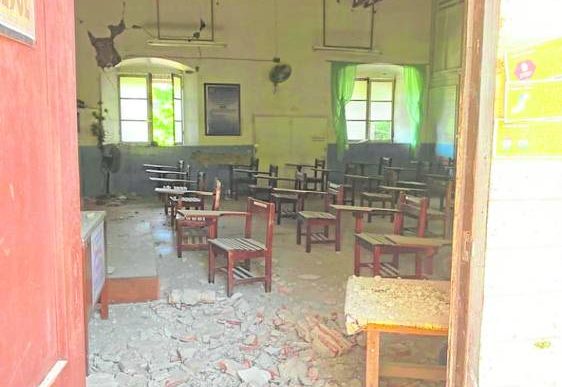
OFF-LIMITS | Holy Spirit Academy of Bangued in Bangued, Abra, is among the schools that suffered heavy damage from the July 27, 2022, earthquake. (Photo by CATHERINE BULDA-BALLESTRA / Contributor)
BAGUIO CITY, Benguet, Philippines — Classes in the Cordillera region will open for the new school year on Aug. 22 as scheduled despite the destructive magnitude 7 earthquake on July 27, the Department of Education (DepEd) announced on Tuesday.
But in areas where schools and classrooms were damaged by the earthquake, students may continue taking home activity books or modules while having online lessons, Estela Cariño, DepEd Cordillera director, said at a briefing arranged by the Office of Civil Defense (OCD). At least 233 of 293 classrooms destroyed by the quake in the region are in Abra province, the quake’s epicenter.
Throughout the Cordillera, the number of classrooms with major damage reached 549, while 1,023 classrooms assessed by engineers had relatively minor damage, said Frankie Cortez, the OCD Cordillera operations chief.
Hybrid lessons
Abra’s Holy Spirit Academy, one of the province’s oldest schools and a former all-girls facility, was among the schools that were badly hit.
The walls of the Catholic school, which is in the capital town of Bangued, bore cracks or holes. Its classrooms and corridors were covered in rubble following the intense jolt.
For school buildings that could still be used despite the damage that would not pose a threat to safety, administrators were advised to proceed with in-person classes that would be augmented with hybrid lessons online and through workbooks, Cariño said.
“Undamaged schools will proceed with in-person classes. Should they have extra unoccupied classrooms, these facilities will accommodate pupils of neighboring damaged schools,” she said.
Cariño added: “I have given instructions that rooms [in safe school buildings], like the principal’s office, must be vacated so we can have more classroom areas for [pupils] from damaged schools.”
Teachers and students who have been traumatized by the quake would be given time to rest before Aug. 22, she said.
Some parents in quake-affected towns have requested that DepEd delay the school opening for two weeks, but the department could not accommodate their request.
No estimates have been made available about the cost of repairing or rebuilding the classrooms.
“We need to conduct another inspection of schools in Abra to clear up conflicting reports,” Cariño told the Inquirer.
But during the Brigada Eskwela kickoff in Cavite province on Monday, Vice President and Education Secretary Sara Duterte said about P1.4 billion would be needed to repair the damaged schools in Luzon.
Repair
Nelia Antonio, chief of construction of the Department of Public Works and Highways in the Cordillera, said DepEd had yet to request for repairs, but once funds are released, rebuilding classrooms would take months “depending on their condition after the quake.”
In this city, government engineers and private sector volunteers began assessing schools on July 28, said Councilor Mylen Yaranon, an architect who joined the inspection tours.
The Baguio chapter of the United Architects of the Philippines was among the professional organizations that inspected 23 public schools as of July 29.
Gilmore Gavino, a structural engineer, found cracks on the stonewall beside Roxas Elementary School which might affect its Grade 8 building, Yaranon said.
But other schools, like Crystal Cave Elementary School, have been cleared for occupancy, she said.
The infrastructure damage left by the quake was pegged at P515.94 million in Cordillera alone, Antonio said.
Based on initial government estimates, at least P1 billion is needed for the rehabilitation of these buildings, including those in the nearby Ilocos region.
Except for one highway, major roads in the Cordillera have been reopened, Antonio said.
Workers continue to clear the landslide debris at the Mt. Data cliffs along the Halsema Highway, she added.
Marciana Madadsek, senior economic development specialist of the National Economic and Development Authority in the Cordillera, said the overall damage estimate for the region was P564 million, 96 percent of which involved roads, bridges, and flood control facilities.

